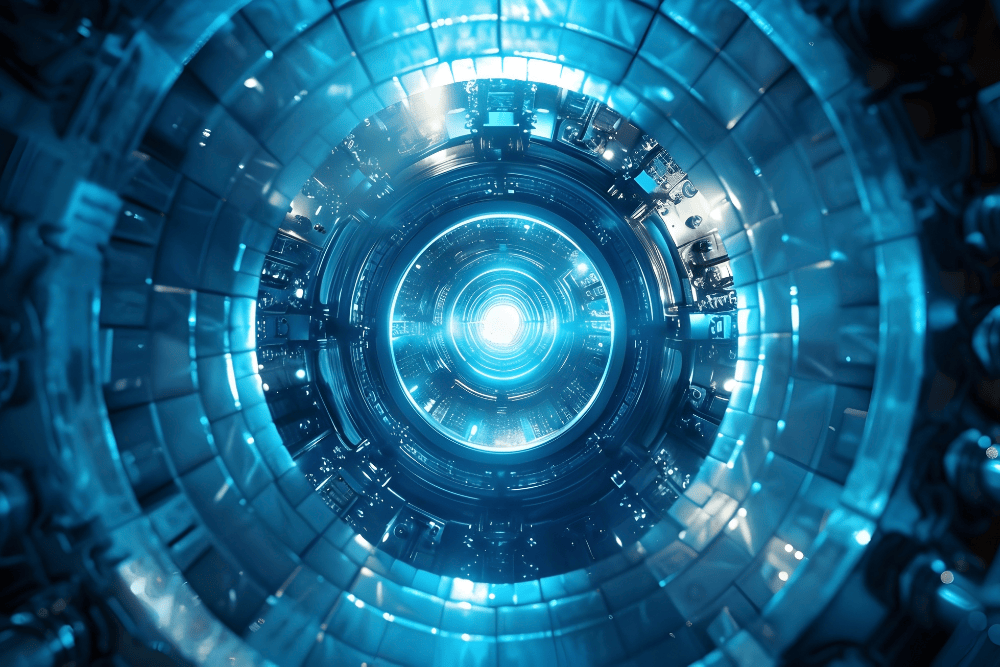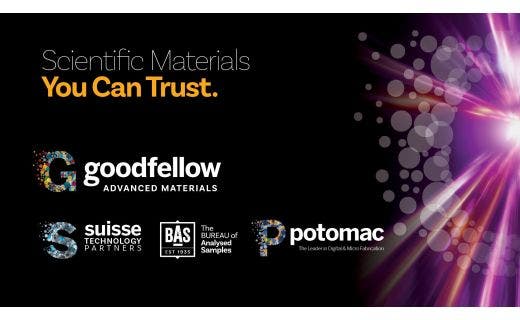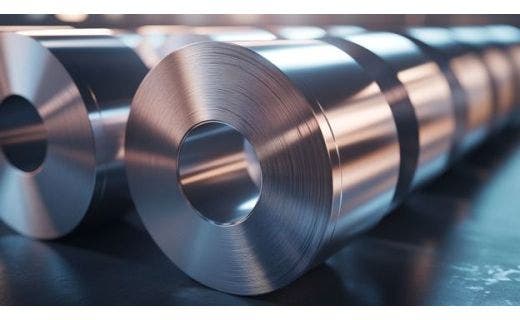CASE STUDY: Goodfellow Materials Power Historic Fusion Ignition Breakthrough at LLNL
On December 5, 2022, the Lawrence Livermore National Laboratory (LLNL) in California achieved a monumental milestone: fusion ignition at the National Ignition Facility (NIF). This historic demonstration marked the first time a laboratory experiment produced more energy from a fusion reaction than the energy used to initiate it: a condition known as ignition.
Goodfellow Ltd. is proud to have provided critical, specialized materials that contributed to this groundbreaking achievement, helping to overcome one of the major barriers to producing clean energy.
The NIF experiment involved firing the facility’s 192 powerful lasers onto a BB-sized target of deuterium and tritium (DT), heavier isotopes of hydrogen. By delivering 2.05 megajoules (MJ) of laser energy, LLNL scientists achieved a fusion energy output of 3.15 MJ, demonstrating a net energy gain. This peer-reviewed and externally verified result confirms the fundamental principles of inertial confinement fusion (ICF), marking a transformative breakthrough for fusion energy and a critical step toward the pursuit of limitless, clean power.
“Simply put, this is one of the most impressive scientific feats of the 21st century.” (U.S. Secretary of Energy Jennifer M. Granholm)
“This is the breakthrough everybody has been waiting for, and it is exciting to have played a small, but critical part in supporting them on their journey to this discovery.” (Dr. Aphrodite Tomou, Goodfellow’s Head of Technical)


The LLNL historic experiment achieved the first instance of scientific breakeven controlled fusion, with an energy gain factor of 1.5.
Materials Used in Fusion Research
Goodfellow Cambridge provides a comprehensive selection of advanced materials designed specifically for fusion research applications. Our materials meet the highest standards for durability, stability, and performance in extreme environments. Additionally, we offer custom manufacturing and material production services—if our standard product range doesn’t meet your needs, please contact us to discuss tailored solutions.
Metals with High Hydrogen Permeability for Fusion Research Applications
In fusion research, metals with high hydrogen permeability play critical roles in processes like hydrogen separation and tritium recovery. Goodfellow can support the following key metals and their alloys for optimizing hydrogen and tritium management in fusion reactors. Their selection depends on specific application requirements, including permeability, strength, selectivity for hydrogen and resistance to embrittlement.
Palladium (Pd) and Palladium Alloys
- Palladium-silver (Pd-Ag) alloys
- Palladium-copper (Pd-Cu) alloys
Vanadium (V) and Vanadium Alloys
- Vanadium-titanium (V-Ti) alloy
- Vanadium-titanium-nickel (V-Ti-Ni) alloy
Tungsten (W) and Tungsten Alloys
- Pure tungsten
- Tungsten-vanadium alloys
Nickel (Ni) and Nickel Alloys
- Nickel-cobalt (Ni-Co) alloys
- Nickel-molybdenum (Ni-Mo) alloys
Iron-Chromium-Aluminum (Fe-Cr-Al) Alloys
Zirconium (Zr) and Zirconium Alloys
- Zircaloy
- Zr-Ni alloy
Tantalum (Ta)
Pure Tantalum
Other Key Materials for Fusion Applications
Other key materials for fusion research available from Goodfellow include:
- Berryllium (Be)
- Ceramics (e.g. alumina, zirconia)
- Copper (Cu)
- Molybdenium (Mo)
- Niobium (Nb)
75+
Years of facilitating scientific innovation
170K
Huge range of advanced materials
111
Countries served globally
ISO9001
Quality assured products
- Wollaston Platinum/Rhodium Alloy Spooled Wire (Pt90/Rh10) Grade: Wollaston
Formula: Pt90/Rh10
Product Shape: Spooled
Diameter: 0.005mm
Length: 0.1m
Outside Diameter: 0.025 - 0.1mm
UOM Code: 000-066-13
Wollaston wire, Silver coated.
Overall outside diameter approx 0.025mm - 0.1mm.
The weight shown is for the core only.
The Silver outer sheath may be dissolved in aqueous 10% Nitric Acid.eachStarting at $383.54
In stockDiscounts applied for volume purchasesGrade: Wollaston Formula: Pt90/Rh10Product Shape: Spooled Diameter: 0.005mmLength: 0.1mOutside Diameter: 0.025 - 0.1mmUOM Code: 000-066-13Wollaston wire, Silver coated.Overall outside diameter approx 0.025mm - 0.1mm.The weight shown is for the core only.The Silver outer sheath may be dissolved in aqueous 10% Nitric Acid. - Silver/Zirconium/Copper Alloy Powder (Ag97/Zr 2/Cu 1) Formula: Ag97/Zr 2/Cu 1
Maximum Particle Size: 45µm
Weight: 10000g
Colour: Green
UOM Code: 124-603-66
eachStarting at $295.66
In stockDiscounts applied for volume purchasesFormula: Ag97/Zr 2/Cu 1Maximum Particle Size: 45µmWeight: 10000gColour: GreenUOM Code: 124-603-66 - Silver/Palladium Alloy Tube (Ag70/Pd30) Formula: Ag70/Pd30
Outside Diameter: 2.2mm
Wall Thickness: 0.1mm
Inside Diameter: 2mm
Length: 100mm
UOM Code: 239-521-57
eachStarting at $324.64
In stockDiscounts applied for volume purchasesFormula: Ag70/Pd30Outside Diameter: 2.2mmWall Thickness: 0.1mmInside Diameter: 2mmLength: 100mmUOM Code: 239-521-57 - Silver/Palladium Alloy Foil (Light Tight) (Ag70/Pd30) Formula: Ag70/Pd30
Temper: As Rolled
Thickness: 0.15mm
Length 1: 100mm
Length 2: 100mm
UOM Code: 853-615-42
eachStarting at $614.68
In stockDiscounts applied for volume purchasesFormula: Ag70/Pd30Temper: As RolledThickness: 0.15mmLength 1: 100mmLength 2: 100mmUOM Code: 853-615-42 - Silver/Gold Alloy Pellets (Ag70/Au30) Formula: Ag70/Au30
Maximum Lump Size: 4mm
Weight: 10g
UOM Code: 866-192-24
eachStarting at $390.10
In stockDiscounts applied for volume purchasesFormula: Ag70/Au30Maximum Lump Size: 4mmWeight: 10gUOM Code: 866-192-24 - Silver/Gold Alloy Foil (Light Tight) (Ag70/Au30) Formula: Ag70/Au30
Temper: As Rolled
Thickness: 0.25mm
Length 1: 20mm
Length 2: 20mm
UOM Code: 530-210-45
eachStarting at $0.00
In stockDiscounts applied for volume purchasesFormula: Ag70/Au30Temper: As RolledThickness: 0.25mmLength 1: 20mmLength 2: 20mmUOM Code: 530-210-45 - Silver/Copper Alloy Wire (Ag72/Cu28) Formula: Ag72/Cu28
Diameter: 0.25mm
Length: 100m
Temper: As Drawn
UOM Code: 071-465-25
eachStarting at $167.73
In stockDiscounts applied for volume purchasesFormula: Ag72/Cu28Diameter: 0.25mmLength: 100mTemper: As DrawnUOM Code: 071-465-25 - Silver/Copper Alloy Rod (Ag72/Cu28) Formula: Ag72/Cu28
Diameter: 2mm
Length: 1000mm
Temper: As Drawn
UOM Code: 619-935-81
eachStarting at $175.43
In stockDiscounts applied for volume purchasesFormula: Ag72/Cu28Diameter: 2mmLength: 1000mmTemper: As DrawnUOM Code: 619-935-81 - Silver/Copper Alloy Powder (Ag72/Cu28) Formula: Ag72/Cu28
Maximum Particle Size: 45µm
Weight: 50g
UOM Code: 063-953-51
eachStarting at $251.14
In stockDiscounts applied for volume purchasesFormula: Ag72/Cu28Maximum Particle Size: 45µmWeight: 50gUOM Code: 063-953-51 - Silver/Copper Alloy Foil (Light Tight) (AG95/Cu5) Formula: AG95/Cu5
Thickness: 1mm
Length 1: 250mm
Length 2: 250mm
UOM Code: 344-349-77
eachStarting at $0.00
In stockDiscounts applied for volume purchasesFormula: AG95/Cu5Thickness: 1mmLength 1: 250mmLength 2: 250mmUOM Code: 344-349-77 - Silver/Copper Alloy Foil (Light Tight) (Ag72/Cu28) Formula: Ag72/Cu28
Thickness: 2mm
Length 1: 100mm
Length 2: 100mm
UOM Code: 310-875-26
eachStarting at $146.38
In stockDiscounts applied for volume purchasesFormula: Ag72/Cu28Thickness: 2mmLength 1: 100mmLength 2: 100mmUOM Code: 310-875-26 - Silver/Copper Alloy Disk (Ag72/Cu28) Formula: Ag72/Cu28
Thickness: 0.05mm
Diameter: 4.2mm
UOM Code: 452-576-49
eachStarting at $124.19
In stockDiscounts applied for volume purchasesFormula: Ag72/Cu28Thickness: 0.05mmDiameter: 4.2mmUOM Code: 452-576-49 - Silver/Copper Alloy Coil (Ag85/Cu15) Formula: Ag85/Cu15
Temper: Hard
Thickness: 0.007mm
Coil Width: 0.1mm
Length: 0.5m
UOM Code: 450-676-31
eachStarting at $180.75
In stockDiscounts applied for volume purchasesFormula: Ag85/Cu15Temper: HardThickness: 0.007mmCoil Width: 0.1mmLength: 0.5mUOM Code: 450-676-31 - Silver/Copper Alloy Coil (Ag72/Cu28) Formula: Ag72/Cu28
Thickness: 0.05mm
Coil Width: 100mm
Length: 0.1m
UOM Code: 279-647-58
eachStarting at $223.49
In stockDiscounts applied for volume purchasesFormula: Ag72/Cu28Thickness: 0.05mmCoil Width: 100mmLength: 0.1mUOM Code: 279-647-58 - Silver/Antimony Alloy Spooled Wire (Ag99/Sb 1) Formula: Ag99/Sb 1
Product Shape: Spooled
Diameter: 0.5mm
Length: 0.025m
Temper: As Drawn
UOM Code: 608-346-85
eachStarting at $300.41
In stockDiscounts applied for volume purchasesFormula: Ag99/Sb 1Product Shape: Spooled Diameter: 0.5mmLength: 0.025mTemper: As DrawnUOM Code: 608-346-85 - PTFE Platinum/Iridium Alloy Insulated Wire (Pt90/Ir10) Formula: Pt90/Ir10
Conductor Diameter: 0.025mm
Insulation: PTFE (Polytetrafluoroethylene)
Insulation Thickness: 0.005mm
Length: 20m
UOM Code: 204-461-26
eachStarting at $278.64
In stockDiscounts applied for volume purchasesFormula: Pt90/Ir10Conductor Diameter: 0.025mmInsulation: PTFE (Polytetrafluoroethylene)Insulation Thickness: 0.005mmLength: 20mUOM Code: 204-461-26 - PTFE (Polytetrafluoroethylene) Gold/Iron Alloy Insulated Wire (Au99.93/Fe 0.07 (Atomic %)) Formula: Au99.93/Fe 0.07 (Atomic %)
Conductor Diameter: 0.1mm
Insulation: PTFE (Polytetrafluoroethylene)
Insulation Thickness: 0.01mm
Length: 0.1m
UOM Code: 324-413-63
eachStarting at $299.55
In stockDiscounts applied for volume purchasesFormula: Au99.93/Fe 0.07 (Atomic %)Conductor Diameter: 0.1mmInsulation: PTFE (Polytetrafluoroethylene)Insulation Thickness: 0.01mmLength: 0.1mUOM Code: 324-413-63 - Polyimide Platinum/Tungsten Alloy Insulated Wire (Pt92/W 8) Formula: Pt92/W 8
Conductor Diameter: 0.025mm
Insulation: Polyimide
Insulation Thickness: 0.007mm
Length: 20m
UOM Code: 011-005-74
eachStarting at $156.35
In stockDiscounts applied for volume purchasesFormula: Pt92/W 8Conductor Diameter: 0.025mmInsulation: PolyimideInsulation Thickness: 0.007mmLength: 20mUOM Code: 011-005-74 - Polyimide Platinum/Iridium Alloy Insulated Wire (Pt90/Ir10) Formula: Pt90/Ir10
Conductor Diameter: 0.1mm
Insulation: Polyimide
Insulation Thickness: 0.015mm
Length: 10m
UOM Code: 211-298-38
eachStarting at $207.80
In stockDiscounts applied for volume purchasesFormula: Pt90/Ir10Conductor Diameter: 0.1mmInsulation: PolyimideInsulation Thickness: 0.015mmLength: 10mUOM Code: 211-298-38 - Platinum/Tungsten Alloy Spooled Wire (Pt92/W 8) Formula: Pt92/W 8
Product Shape: Spooled
Diameter: 0.025mm
Length: 100m
Temper: As Drawn
UOM Code: 118-875-10
eachStarting at $193.45
In stockDiscounts applied for volume purchasesFormula: Pt92/W 8Product Shape: Spooled Diameter: 0.025mmLength: 100mTemper: As DrawnUOM Code: 118-875-10
Working as your experienced partner in the nuclear fusion sector, we can find and supply the highest quality materials for your products. Our nuclear energy applications and innovative alloys can help you achieve unparalleled performance and better energy efficiency in building and plant design.
Why Goodfellow?
- No minimum order
- Over 175,000 advanced materials
- Supply Chain Management:
- sourcing custom materials for your needs
- Dispatched globally within 48 hours
- Materials customization:
- Custom parts for prototyping | Full product modification | Micro-machining | Microfabrication | Rolling
- Free and fast delivery: Worldwide shipping and customs clearance, to your door. All orders are dispatched within 48 hours
- Commercial arrangements:
- Call off orders | Buffer stock | Fixed and contract pricing | Discounts for increased volumes
- We help you innovate into the future.


*Conditions apply
What's New
Recent posts



Be in the know
Sign Up for our latest materials insight, projects and offers.
Resources and References
Zinkle, S. J., & Was, G. S. (2013). Materials challenges in nuclear energy. Acta Materialia, 61(3), 735–758. https://doi.org/10.1016/j.actamat.2012.11.004
IAEA (2016) https://www-pub.iaea.org/MTCD/publications/PDF/Pub1715web-46541668.pdf, accessed January 2023






















